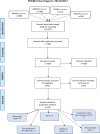Quality circles for quality improvement in primary health care: Their origins, spread, effectiveness and lacunae- A scoping review
- PMID: 30557329
- PMCID: PMC6296539
- DOI: 10.1371/journal.pone.0202616
Quality circles for quality improvement in primary health care: Their origins, spread, effectiveness and lacunae- A scoping review
Abstract
Quality circles or peer review groups, and similar structured small groups of 6-12 health care professionals meet regularly across Europe to reflect on and improve their standard practice. There is debate over their effectiveness in primary health care, especially over their potential to change practitioners' behaviour. Despite their popularity, we could not identify broad surveys of the literature on quality circles in a primary care context. Our scoping review was intended to identify possible definitions of quality circles, their origins, and reported effectiveness in primary health care, and to identify gaps in our knowledge. We searched appropriate databases and included any relevant paper on quality circles published until December 2017. We then compared information we found in the articles to that we found in books and on websites. Our search returned 7824 citations, from which we identified 82 background papers and 58 papers about quality circles. We found that they originated in manufacturing industry and that many countries adopted them for primary health care to continuously improve medical education, professional development, and quality of care. Quality circles are not standardized and their techniques are complex. We identified 19 papers that described individual studies, one paper that summarized 3 studies, and 1 systematic review that suggested that quality circles can effectively change behaviour, though effect sizes varied, depending on topic and context. Studies also suggested participation may affirm self-esteem and increase professional confidence. Because reports of the effect of quality circles on behaviour are variable, we recommend theory-driven research approaches to analyse and improve the effectiveness of this complex intervention.
Conflict of interest statement
The authors report no conflicts of interest. AR works as a general practitioner at medbase Health Care Centres, a network providing primary health care services in Switzerland. As a member of the committee for quality improvement in the Swiss Society of General Internal Medicine, he supervises and trains facilitators. GW, SM, KT, and JH independently contributed their academic and methodological experience to this project. This does not alter our adherence to PLOS ONE policies on sharing data and materials.
Figures
References
-
- Onglatco MU, Matsui T. The Anatomy of Japanese Quality Circles 1991 [Les circles de Qualité]. Available from: http://civilisations.revues.org/index1666.html.
-
- Diel F. Qualitätszirkel 2013 [German Definition of Structured Small Group Work]. Available from: http://www.kbv.de/html/qualitaetszirkel.php. German.
-
- Garbutt D, Dunion L, Walker S, Ford L, Steele D, Tannahill A, et al. Welcome to the Practice Based Small Group Learning (PBSGL) Glasgow: National Health Service Scotland; 2015. [cited 2015 10/09]. PBSGL Home Page]. Available from: http://www.nes.scot.nhs.uk/education-and-training/by-theme-initiative/pa....
-
- Kirk UB. European Society of Quality and Safety in Primary Health Care (EQuiP): a network organisation within WONCA Region Europe 2015 [Available from: http://equip.woncaeurope.org/outputs/72-peer-reviewed-activities-2015-2011.
-
- Arvidsson GA, Elmroth U. PrimärvardsKvalitet—lanseringen fortsätter! [Quality in primary health care—the launch continues]. Allmän Medicin [Internet]. 2016. 25/10/2016 [cited 2016 10/8]; 2 Available from: http://sfam.se/artiklar/primarvardskvalitet-lanseringen-fortsatter. Swedish.




